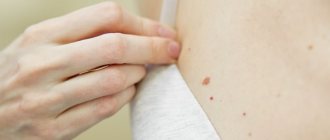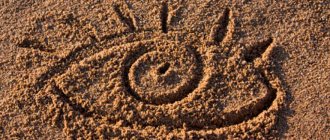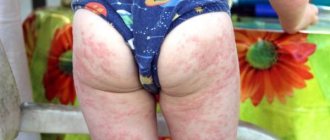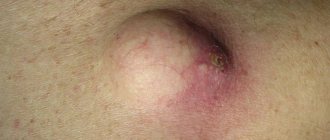Eczema is a chronic skin pathology that manifests itself in the form of foci of inflammation on the body, arms, legs and head. Rashes that form on the skin go through several stages of development: primary redness, dense nodules that transform into blisters, then weeping erosions form, which during the healing process are covered with a scab (the so-called “crust”). The last stage is peeling. Against the background of eczema, secondary purulent infections often develop. If left untreated for a long time, cosmetic defects of the skin may appear in patients of all ages.
Causes and symptoms of the disease
Doctors cannot give a definite answer to the question of what are the basic conditions for the development of pathology. Among the causes of eczema in patients, the following factors are considered:
- genetic conditioning;
- chronic allergies;
- pathologies of the endocrine system;
- psycho-emotional triggers.
Dermatologists distinguish several types of eczema: true, microbial, occupational and seborrheic. The clinical picture in each case turns out to be unique, as are the factors that provoke the inflammatory process on the surface of the skin.
| Types of eczema | Symptoms | Diagnosis of eczema |
| True | Symmetrical foci of inflammation in open areas of the skin, hyperpigmentation, weeping surface. Later, numerous vesicles form, in place of which microscopic erosions gradually develop. Exudate accumulates on them. Patients experience attacks of itching, and as the vesicles heal, peeling of the skin occurs | Diagnosis is carried out by a dermatologist during an examination of the patient. Symmetrical rashes on the arms, legs or face indicate that a child or adult is experiencing true eczema. |
| Microbial | Develops against the background of traumatic skin injuries, fungal, bacterial or viral infections. The lesions are asymmetrical and concentrated on the patient’s lower extremities. Varicose veins become a risk factor. Failure to comply with the rules of personal hygiene leads to the accelerated development of pathology. Under the skin adjacent to the pathological focus, accumulations of infiltrate are formed | The diagnosis is established by taking a history and visual examination of the patient. The doctor pays attention to traumatic injuries to the skin of the lower extremities, mycoses, and varicose veins. Bacteriological studies of scrapings are performed to identify the resistance of the eczema pathogen to antibiotics |
| Professional | It develops against the background of the patient’s professional activity due to regular contact of the skin with allergens: chemicals, dust, cleaning products, air with atypical humidity. The size of the rash varies. Foci of inflammation can be located on any part of the patient’s body. A characteristic symptom of eczema is an abundance of small vesicles | The main diagnostic technique is to exclude the factor that provokes inflammatory processes. If the professional nature of the rash is confirmed, the dermatologist can prescribe the appropriate course of treatment to the patient. |
| Seborrheic | Affects the skin of the scalp. The affected areas are dry and profusely peeling. Itching intensifies after performing hygiene procedures. Zones of inflammation have distinct boundaries. In some cases, the course of the disease is complicated by the formation of swelling and weeping cracks in the surface layers of the skin | Some dermatologists do not agree that seborrheic eczema can be considered an independent type of pathology (changes in the skin are considered a special case of the true type of disease). The main diagnostic technique is histological examination of cells to exclude microbial eczema from the diagnostic report |
Are you experiencing symptoms of eczema?
Only a doctor can accurately diagnose the disease. Don't delay your consultation - call
I. Stigmas of pregnancy:
Chloasma is the most famous of them. Various functional endocrine-metabolic changes during pregnancy are suggested as a development mechanism. It appears as brownish spots of vague outline, often symmetrical, on the skin of the cheeks, forehead, chin, neck without subjective sensations. Chloasma can occur at different stages of gestation, intensifying as it develops and disappearing without a trace soon after birth. But in subsequent pregnancies, chloasma occurs again. Exposure to sunlight increases the severity of spots.
Melanosis of pregnancy - changes on the skin in the form of hyperpigmentation in the area of the nipples, genitals, white line of the abdomen, also without subjective sensations or inflammatory phenomena. After childbirth, these disorders disappear. Chloasma and melanosis usually do not require special treatment and spontaneously regress after childbirth.
Treatment and prevention
The above classification of eczema and description of the symptoms of the disease indicate the impossibility of self-treatment. Consultation with a dermatologist and consistent adherence to his recommendations remain the only way to relieve seasonal exacerbations. The key task of the doctor is to identify provoking factors. After this, a treatment strategy is formed - medications are prescribed to treat eczema. It may include systemic and local therapy. Physiotherapeutic procedures are an additional option.
Systemic therapy
The basis of drug treatment is antihistamines, which are designed to reduce the risk of developing acute allergic reactions of the patient to various internal and external factors. Sedatives are prescribed against the background of high psycho-emotional stress experienced by adults and children. Plasmapheresis and other types of hemocorrection are used in severe cases of the disease complicated by systemic pathologies.
If the effectiveness of the treatment is low, the doctor may prescribe the patient oral glucocorticosteroids. As the condition of the child or adult improves, the dose of hormonal drugs is reduced.
Local therapy
Retinol ointment is applied to local areas of inflammation. An alternative can be applications of pastes with keratolytic properties. Anti-inflammatory and antiseptic components contribute to the successful elimination of bacteria, viruses or fungal infections. If there are a significant number of vesicles, the patient is prescribed drugs with individually selected components. Their combination is based on the clinical picture of the pathology and the cause of inflammatory processes on the skin identified during diagnosis.
Physiotherapy
Physiotherapeutic complexes include:
- ozone therapy;
- magnetic therapy;
- laser stimulation.
In difficult cases, a dermatologist may insist on treating eczema-affected skin areas using cryotherapy. After overcoming the acute phase of the disease, therapeutic and mud baths are recommended for children and adults. In some cases, irradiation of damaged skin areas with ultraviolet rays is prescribed. To determine the correct treatment, the dermatologist may refer the patient to a physical therapist.
Preventive measures
If signs of eczema are detected, patients should seek advice from a dermatologist. After confirming the diagnosis, you should follow a diet - you must exclude foods that can provoke allergic reactions from your diet. It is recommended to refrain from drinking alcohol and smoking cigarettes.
Personal hygiene rules when treating eczema of the feet, hands, arms, legs or face include avoiding scented soaps. To moisturize the skin, it is permissible to use water-based creams.
How is eczema treated during pregnancy?
Since eczema during pregnancy can have a different course, methods for correcting symptoms are selected individually. The general principle of treatment is to prescribe ointments and other local remedies that will have minimal effect on the woman’s body.
Perhaps, in addition to a dermatologist and gynecologist, you will need to consult other specialists, for example, a gastroenterologist, who will rule out stomach diseases, or an ENT specialist, who will detect inflammation of the ENT organs. This is explained by the fact that the cause of exacerbation of eczema may be another disease. Taking this into account, as well as taking into account the gestational age and symptoms, the doctor selects how and with what to treat eczema during pregnancy.
Hormonal drugs
You can use hormonal ointments only as prescribed by a doctor. Such drugs can have a negative effect on the fetus. For this reason, they are not used in the first trimester of pregnancy. Most hormonal ointments are allowed from 12-16 weeks and provided that the potential benefit to the woman is greater than the risk to the fetus. This can only be assessed by a specialist who will take into account the ability of a particular drug to penetrate the placenta and its effect on the tone of the uterus.
They try to prescribe hormonal ointments for eczema during pregnancy in extreme cases, when normalization of the diet and non-hormonal remedies have not produced results. Another rule is to use such serious drugs in short courses and only topically, that is, for treating the skin and not for oral administration.
Non-hormonal drugs
In most cases, treatment of eczema in pregnant women occurs with the use of non-hormonal ointments, which have a gentle effect on the woman’s body, helping to eliminate inflammation and unpleasant symptoms. Among such drugs are Bepanten, Elidel, and Zinc ointment.
At the PsorMak clinic, for treatment they use a non-hormonal ointment based on plant components, developed according to the original method of Dr. V. F. Mak, who has more than 25 years of experience in dermatology. The unique treatment method has already helped hundreds of patients, as can be seen by studying their reviews and treatment results. Herbal ointment does not irritate the skin and does not aggravate the course of the disease, but gently relieves redness, inflammation, itching and other unpleasant symptoms of eczema.
Diet and prevention
In order not to provoke an exacerbation of eczema, a woman needs to follow a diet. It is healthy to eat a lot of vegetables and fruits, fresh herbs, cereals, lean meats, and dairy products. Must be avoided:
- baking,
- chocolate,
- citrus fruits,
- nuts,
- whole cow's milk,
- seafood,
- red vegetables and fruits,
- honey
Your home should be free of any allergens, such as feather pillows or carpets, that may harbor mites. It is necessary to have less contact with household chemicals - carry out cleaning and wash dishes using gloves. Clothes should be made from soft natural fabrics with a small content of viscose, without synthetics and wool.
It is equally important to maintain the correct daily routine, avoid stress, relax and spend more time in the fresh air.
And the most important thing is not to self-medicate, but at the first unpleasant symptoms, immediately consult a doctor so as not to aggravate the disease and cope with it faster through timely measures taken. If you encounter eczema during pregnancy, contact the PsorMak clinic, where you can be diagnosed and receive the correct treatment. November 5, 2021
Author of the article: dermatologist Mak Vladimir Fedorovich
Questions and answers
Are there differences in the causes of eczema on the hands and eczema on the feet?
The appearance of foci of inflammation on the extremities is in most cases associated with traumatic factors or exposure to aggressive chemicals. The formation of vesicles or weeping on the body is often the result of allergic reactions and systemic pathologies identified in patients.
What are the main clinical recommendations for diagnosed eczema?
A patient with a confirmed diagnosis of eczema should discuss with a dermatologist the advisability of consultations with other doctors: endocrinologist, allergist, gastroenterologist. Their use can reduce the frequency of exacerbations of the disease and reduce the intensity of reactions to factors that provoke the inflammatory process.
Do patients with chronic eczema need to take any medications regularly?
Drug and hardware treatment along with courses of physiotherapy are prescribed during periods of exacerbations. After relief of acute symptoms of the disease, the patient does not need to systematically take medications. A significant role during this period is played by the child or adult’s compliance with the recommendations of the attending physician and preventive measures.
Symptoms of microbial eczema
The characteristic symptoms of this disease depend on its type. But there are common features that are common to all five types:
- Severe, severe redness of the affected areas of the skin (erytherma);
- Irregular, asymmetrical shape of the lesions;
- The appearance of a weeping, purulent papule in the center of the inflamed area;
- Formation of dying epithelium, hardened crusts;
- The patient feels severe itching and burning in the area of inflammation.
The location of the papules shows the form in which the disease occurs. These elements may appear on the cheeks, chin, around the nipples, and in the upper and lower joint limbs. Usually individual lesions can be seen in a specific location. But if treatment is not started in time, swelling and purulent formations spread throughout the body.
Is microbial eczema contagious?
This type of bacterial disease cannot be transmitted by shaking hands or kissing. This disease is not considered one hundred percent contagious. It can occur in the body of a healthy person only with the simultaneous occurrence of infections of a bacterial or fungal nature.
| Appointment with a dermatologist at the clinic. Call a dermatologist at home. | Reception is strictly by appointment, make an appointment by phone: +7 | Prices for services | Reviews about the clinic |
Treatment of microbial eczema
Treatment of the disease is carried out in the following ways:
- Local, local therapy;
- Taking specific medications (tablets, ointments);
- Physiotherapeutic procedures;
- Compliance with the requirements for the correct daily routine;
- Organization of healthy, wholesome nutrition.
Therapy based on pharmacological agents takes first place among other methods. The doctor prescribes medications that remove swelling. The patient treats the inflamed areas with ointments and gels (prednisolone, hydrocortisone, fucorcin, fenistil, etc.). Antiseptic solutions are used to treat and clean the infected areas. All tablets and ointments should be used only after the recommendations of a specialist.
The term “eczema” has been known since ancient times. However, to date, it has been interpreted differently in different countries. Recently, in Europe and North America, the terms “dermatitis” and “eczema” are practically synonymous [1, 2]. At the same time, no one denies the presence of a nonspecific pathological reaction of the skin, manifested by inflammation in the epidermis and dermis, which is typically characterized by the presence of focal swelling of the spinous layer of the epidermis - spongiosis. This reaction is traditionally called eczematous and takes part in the formation of the clinical picture of many skin diseases, both infectious and non-infectious. In cases where, after eliminating the etiological factor, the manifestations of the disease are completely resolved, they speak of secondary eczematization of some process. This often occurs with streptoderma, mycosis of the feet, and scabies. At the same time, in some patients an eczematous reaction occurs primarily. This is typical for allergic contact dermatitis. In most cases, after eliminating the allergen, the manifestations of the disease resolve.
In some cases, the manifestations of the disease do not resolve completely, and the nature of its course becomes chronically relapsing. In the future, various factors acting both directly on the skin and on the body as a whole act as provoking exacerbations of the disease. In such cases, in Russia it is customary to talk about eczema as an independent nosological unit.
At the same time, a significant number of patients have indications of manifestations of atopic dermatitis in early childhood and extracutaneous manifestations of atopy (atopic bronchial asthma, allergic rhinitis, hay fever), an increase in general and the presence of specific IgE is detected. Apparently, in such cases it is more correct to talk about the special course of atopic dermatitis with localized eczematous manifestations. Currently, in the specialized literature, instead of the term “atopic dermatitis,” the term “atopic eczema” is widely used.
There is no common understanding of the term “hand eczema”. However, most authors describe chronic lesions of the skin of the hands, manifested by an eczematous reaction, which is characterized by polyvalent sensitivity, i.e. the development of relapses and exacerbations of the disease is associated with various effects both directly on the skin and on the body as a whole (chemical, physical, meteorological, psychological stress, etc.). The incidence of eczema, according to the literature [3, 4], in different countries is 5-20%. A significant role in the development of hand eczema is currently attributed to disruption of the skin barrier, which is confirmed, in particular, by the positive results of using basic skin care products [5, 6]. During inflammation in the skin, the production and secretion of lipids by keratinocytes is disrupted. The consequence of this is an increase in intercellular spaces and a decrease in the elasticity of keratinocytes. Increased permeability of the skin barrier leads to the penetration of both allergens and irritants into the skin, further increasing inflammation. The emerging “vicious circle” ensures the chronicization of the skin process [7, 8].
The multifactorial origin of hand eczema in most cases does not allow achieving long-term complete remission of the disease and requires the selection of constant maintenance therapy. Many patients without proper medical supervision use topical glucocorticosteroids (TGCS) for a long time, resulting in the formation of local steroid dependence and other local side effects of long-term use of drugs in this group. Patients in the other group categorically refuse to use local steroids, allowing uncontrolled inflammation to develop in the future. Very often we have to admit that patients with hand eczema neglect basic skin care products.
Refusal to use TGCS significantly lengthens the treatment period for patients and worsens their quality of life [9].
Currently, the drugs that best meet modern requirements include the local steroid mometasone furoate, which has high systemic safety [10, 11].
For more than 10 years, experience has been accumulated in the use of intermittent treatment regimens with topical steroids. Back in 1999, N. Veien et al. [12] showed the high effectiveness and safety of long-term (36 weeks) intermittent (the drug was prescribed according to the so-called weekend regimen - only on Saturday and Sunday in one group and every other day in the other) steroid therapy to control the disease, especially with dorsal localization of manifestations eczema of the hands. More recent studies have shown that the best treatment results are achieved with a combination of local GCs and emollients [13, 14].
Material and methods
We observed 34 patients with hand eczema aged from 17 to 62 years (24 women, 10 men; average age 30.45±1.32 years).
The severity of eczema manifestations was assessed based on the EASI (Eczema Area Severity Index) using standard methods. If EASI was 3–6, then the exacerbation was considered non-severe, 7–9 – moderate, 10 or more – severe.
Depending on the severity of inflammatory changes in the skin, the drug Uniderm (mometasone furoate 0.1% cream) was applied to the affected areas of the skin once a day until almost complete resolution of the skin rashes was achieved. Subsequently, patients were transferred to an intermittent regimen of using Uniderm: the drug was applied to the affected areas of the skin for 2 days every 5 days (2 times a week) against the background of daily use of basic care products (special cream or special body emulsion Emolium
).
In the complete absence of manifestations of the disease, topical steroids were not applied; only basic care products were used (cream or body emulsion Emolium
).
The observation period for patients was 8 weeks. Visits were carried out after 2, 4 and 8 weeks of treatment.
Results and discussion
In 25 patients, signs of atopy were identified (onset in early childhood, atopic diseases in blood relatives, extracutaneous manifestations of atopy).
Among patients with hand eczema without atopy (9 people), the majority (8) were patients aged 35-62 years. Among the patients in this group, women predominated (8 out of 9 people). There were no patients with severe disease in this group, and the absolute majority (7 people, 78%) were diagnosed with mild severity. In most cases (6 patients), the disease occurred at an acute stage, characterized by the appearance of superficial grouped microvesicles on the skin of the hands against a background of hyperemia, weeping, accompanied by itching. In the remaining 3 patients, eczema was in the subacute stage.
The vast majority of patients (7 people) noted the connection between the development of the disease and the experience of psycho-emotional stress (divorce, death or illness of a loved one, passing exams, etc.). In 2 patients, rashes first appeared when exposed to exogenous factors (building materials, washing powders, alkaline detergents with antimicrobial action).
In most cases, hand eczema with atopy was observed in young people (25-34 years, average age 29.18±1.4 years). Among the patients in this group, women also predominated. In this group, exacerbation of the disease was assessed as severe in 44% of cases, in 29% - moderate severity, and only 27% of patients were diagnosed with mild severity. 100% of patients in this group had a history of atopy (“childhood eczema” or “diathesis”). Allergic diseases in the family history were noted by 21 (84%) patients. Clinically, all patients showed signs of atopy that fit the well-known criteria of J. Hanifin and G. Rajka. In the majority of patients with eczema of the hands with atopy (21 cases), during periods of exacerbation, symptoms of congestive infiltration, lichenoid papules, lichenification, severe dry skin, cracks and peeling located on the dorsum of the skin of the hands dominated, while exudative manifestations with a tendency to swelling and microvesiculation were found in only 4 patients. Among the provoking factors in this group of patients, psychoemotional stress dominated (in 12 cases). In 13 patients, the disease began in early childhood and according to the descriptions resembled the infant stage of atopic dermatitis, then until a certain age they experienced a stable remission, and only with the onset of pregnancy (in 7 women) and lactation (5) did a relapse of dermatosis occur. Exacerbation of the disease was associated with errors in diet in 11 patients, with exogenous factors - 2, with occupational hazards - 1, the rest could not clearly indicate the cause of exacerbations.
Both among patients with hand eczema without atopy and among patients with hand eczema with atopy, diseases of the gastrointestinal tract were in 1st place in frequency of occurrence (55.6 and 68% of cases, respectively). In 2nd place in patients of both groups were gynecological diseases (22.2 and 32%), in 3rd place were diseases of the endocrine system (11.1 and 12%). Only in 22.2% of patients with hand eczema without atopy and in 24% of patients with hand eczema with atopy, no foci of chronic infections were identified.
After examination, all patients were prescribed individual therapy (systemic and external) depending on the period of the disease, the severity of the pathological process, as well as the identified concomitant pathology and provoking factors. All patients were given general recommendations affecting the patient’s compensatory and adaptive mechanisms (diet, daily routine, treatment of concomitant diseases and functional disorders, job changes, climate therapy, etc.). After assessing the state of the autonomic nervous system, vegetative correctors were prescribed (duration of use from 2 weeks to 2 months). If necessary, patients with moderate and severe severity of the disease received hyposensitizing and detoxifying therapy. Topical glucocorticoids were used externally. Depending on the clinical picture of the disease and the presence of associated complications, Uniderm cream was applied to the affected areas of the skin once a day for no more than 14 days until almost complete resolution of the skin rashes was achieved. Subsequently, patients were transferred to an intermittent regimen of using TGCS: the drug was applied to the affected skin areas for 2 days in a row with an interval of 5 days (2 times a week) against the background of daily use of basic care products. In the absence of any manifestations of the disease, no topical steroid was applied: only basic care products were used.
Both during exacerbation and during remission of the disease, all patients with hand eczema were prescribed drugs that restore the integrity of the skin barrier (so-called emollients, which have a moisturizing and fattening effect). In our study, these were cosmetics from the Emolium
.
After the course of treatment, almost all patients achieved positive results. In 8 out of 9 patients with eczema without atopy, after achieving remission (complete resolution of the rash required 4-7 days of continuous use of Uniderm cream) and short-term (1-2 weeks) intermittent therapy, it was possible to completely abandon topical steroids, subject to constant use of Emolium
. Only in one case did it become necessary to continue intermittent therapy, which can be explained by contacts with irritants due to the patient’s professional activities. At the same time, patients who were diagnosed with an atopic background turned out to be more resistant to the treatment (it took 6-10 days of daily use of Uniderm cream to resolve the rashes). Only 13 patients managed to achieve stable, but incomplete remission within several weeks. In the remaining cases, intermittent therapy with topical steroids (Uniderm) was continued throughout the observation period. Despite the treatment, in 6 cases it was not possible to achieve stable remission of the disease, which can be explained, in particular, by the inability to completely eliminate the provoking factors.
Thus, the administration of modern non-atrophogenic local TGCS Uniderm allows you to quickly suppress the hyperergic reaction, and intermittent therapy using this drug against the background of constant use of basic skin care products Emolium
In most cases, it allows you to actively fight persistent inflammation in the skin and maintain remission of hand eczema. This treatment regimen can be recommended for long-term disease with frequent relapses.
conclusions
1. Modern therapy for hand eczema should include identification and elimination of trigger factors, active anti-inflammatory therapy even with minimal exacerbations of the disease, and constant use of basic skin care products.
2. In patients with eczema of the hands without atopy, resolution of the skin process occurs faster and a more stable remission develops, while in patients with atopic eczema of the hands, resolution of the rash occurs more slowly and exacerbations of the skin process occur more often.
3. Intermittent therapy with modern local steroids (in particular, Uniderm cream) can be recommended for patients with long-term hand eczema with frequent relapses.
4. Patients with hand eczema need constant use of basic skin care products.
5. Basic skin care products from the Emolium
meet modern requirements for this group of medicinal cosmetic products.










